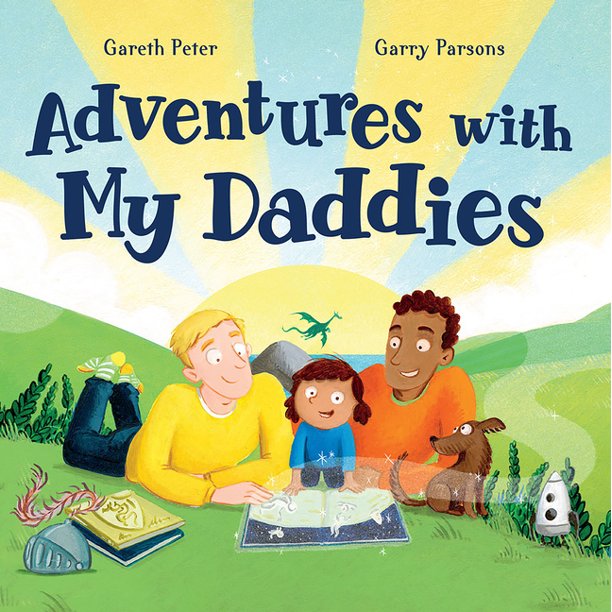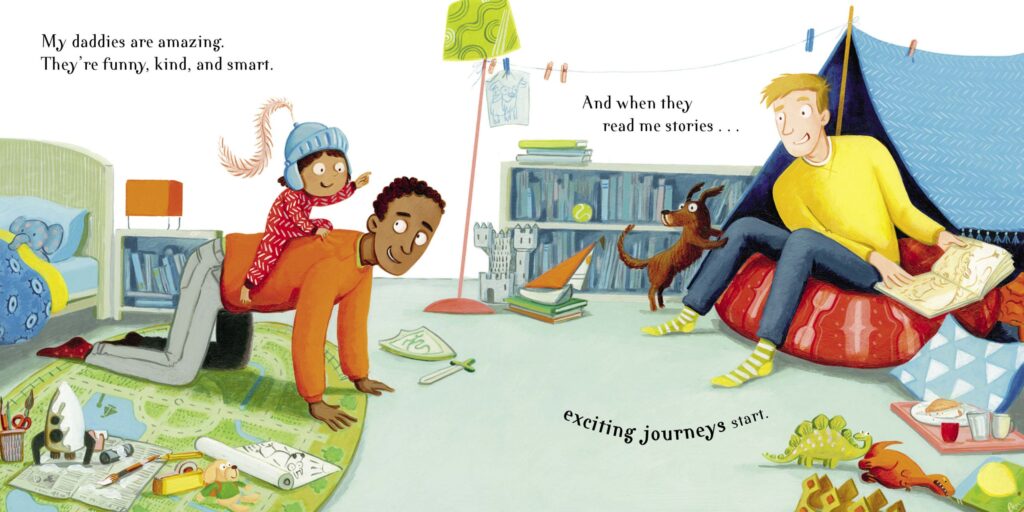
Inclusive Children's Book Teaching Guide
Adventures With My Daddies
What is this book about?
Embark on a series of incredible adventures with a family that has two dads. As these dads read bedtime stories with their little one, this LGBTQ+ led family battles dragons, dodges deadly dinosaurs, zooms to the moon, and explores the world in a hot-air balloon—all before winding down to sleep in a wonderfully cozy ending.
This rhyming read-aloud book celebrates the power of imagination and champions the love that brings all kinds of families together. Author and illustrator team Gareth Peter and Garry Parsons deliver an imaginative, heartwarming tale filled with cheerful acrylic-and-pencil illustrations.
Who is depicted in this book?
- An LGBTQ+ led family
What early childhood themes and concepts does this book explore?
- Families come in different forms
- The ways that family members show love
- Common emotions as depicted in the illustrations in the book
- Pretend and imagination versus reality
How does this book support anti-bias education?
Adventures With My Daddies highlights the love and care that different families provide for their children. The main character in the book is proud of her two dads and sees her family structure in a positive light. Embedded within this affirming story about a child and her two dads is the child’s adoption story, which affirms family diversity in yet another way.
Depending on how the book is shared or used—and the developmental level of the children—Adventures With My Daddies may be used to support the following core goals from Anti-Bias Education for Young Children and Ourselves:
Identity—Teachers will nurture each child’s construction of knowledgeable and confident personal and social identities so that children will demonstrate self-awareness, confidence, family pride, and positive social identities.
Diversity—Teachers will promote each child’s comfortable, empathetic interaction with people from diverse backgrounds so that children will express comfort and joy with human diversity, use accurate language for human differences, and form deep, caring connections across all dimensions of human diversity.
How can this book be used to meet early childhood learning standards?
For all ages
Use Adventures With My Daddies to meet early childhood literacy standards >
For children from birth to age three
Teaching suggestion: Point out examples of children at play, as well as other familiar actions and settings that the youngest children can react to, point at, or name.
What Illinois Early Learning Guideline does this meet for children from birth to age three?
Developmental DomainCognitive Development
Standard: Concept DevelopmentChildren demonstrate the ability to connect pieces of information in understanding objects, ideas and relationships.
Indicators for children:
- Attempts to repeat an action (Birth–9 months)
- Identifies and indicates objects and people in pictures (7–18 months)
- Begins to identify characteristics of objects (16–24 months)
- Identifies characteristics of objects and people when named (21–36 months)
Teaching suggestion: Point out familiar people and relationships depicted in the book, using names that are familiar to the children in your classroom. Connect your book share to your classroom’s display of family photos and memories.
What Illinois Early Learning Guideline does this meet for children from birth to age three?
Developmental DomainLanguage Development, Communication and Literacy
Standard: Receptive CommunicationChildren demonstrate the ability to comprehend both verbal and nonverbal communication.
Indicators for children:
- Recognizes and demonstrates an understanding of familiar pictures, people and objects, e.g., says “mama” while pointing to mother (16–24 months)
- Responds verbally and/or nonverbally to comments or questions while engaged in conversations with both peers and adults (21–36 months)
Teaching suggestion: Point out and model ways that parents show love and care for their children, such as cheering them up when they feel sad, reading together, bath time, meals, and celebrations.
What Illinois Early Learning Guideline does this meet for children from birth to age three?
Developmental DomainSelf-Regulation
Standard: Emotional RegulationChildren demonstrate the emerging ability to identify and manage the expression of emotion in accordance with social and cultural contexts.
Indicators for children:
- Seeks out caregiver through physical actions (7–18 months)
- Seeks caregiver support when feeling overwhelmed by emotion (21–36 months)
For preschoolers (ages three to five)
Teaching suggestion: Together with the children, identify adventures in the illustrations that are really happening and ones that are happening through imagination and pretend.
What Illinois Early Learning and Development Standards does this meet for preschoolers?
Language Arts Standard2BRecognize key ideas and details in stories.
Benchmark 2.B.ECa:
With teacher assistance, ask and answer questions about books read aloud.
Teaching suggestion: Invite the children to talk about family structure. Ask questions such as: "Who is in your family? What is the same and different among your families?" Encourage them to talk about and represent their family members in their play and through creative expression, including who they consider to be a part of their family and the activities that they share.
What Illinois Early Learning and Development Standards does this meet for preschoolers?
Social Studies Standard18BDevelop an awareness of self within the context of family.
Benchmark 18.B.ECa:
Understand that each of us belongs to a family and recognize that families vary.
See inside this book.

What other resources are available?
Visit the publisher’s website for more information about this book, as well as a read-aloud by the author.
